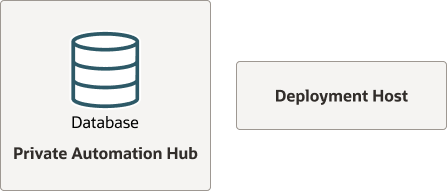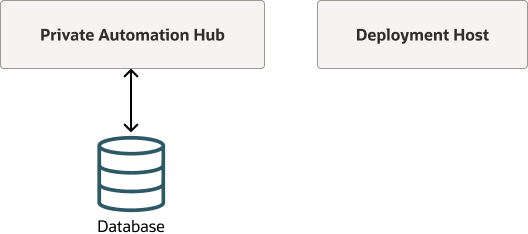1 Preparing to Install Private Automation Hub
This chapter describes the requirements for the systems to be used in an installation of Private Automation Hub.
Private Automation Hub Hardware Requirements
You can install Private Automation Hub on a single machine in x86-64 Oracle Linux 8 hosts.
-
4 GB RAM
-
40 GB disk space (170 GB is recommended)
-
Two core CPU
The preceding list outlines the minimum requirements to run Private Automation Hub. You must determine any additional hardware requirements and capacity based on your operational needs.
Hosts must be configured to establish and accept an ssh connection. Consider setting up passwordless login between the deployment host and target hosts to simplify the installation process. For more information, see Set Up Passwordless SSH.
Installation Options
- Standalone installation: All components of are on the same host, including the database
deployed from the deployment host. The deployment host is a separete system system from
which you install Private Automation Hub and the database.
Figure 1-1 Standalone Installation with Local Database

- Standalone installation with remote database: All components are on the same host, with
the exception of the database which is on a remote host. The deployment host is a
separete system system from which you install Private Automation Hub and the remote
database.
Figure 1-2 Standalone Installation with Remote Database

Set Up Passwordless SSH
Set up passwordless SSH connections from the deployment host to the target hosts.
Passwordless SSH is used to copy the CA certificates to the nodes. This should be set up
for the user on the deployment host that installs Private Automation Hub, for example, for
the opc or oracle user.
Set up passwordless SSH between the deployment host and all target hosts.
For example, one way to set up passwordless SSH to the target hosts, is as follows:
-
On the deployment host, use ssh-keygen to generate a public and private key pair. For example:
ssh-keygen
Generating public/private rsa key pair. Enter file in which to save the key (/home/user/.ssh/id_rsa): <Enter> Created directory '/home/user/.ssh'. Enter passphrase (empty for no passphrase): <Enter> Enter same passphrase again: <Enter> ...
Press
Entereach time you are prompted to enter a passphrase. -
Copy the public key into the
~/.ssh/authorized_keysfile for each target host. - To avoid authentication verification prompts, add authenticated hosts to the
~/.ssh/known_hosts file. For example,
ssh-keyscan -H <host> >> ~/.ssh/known_hosts - To verify that the deployment host can access the target system without supplying a
password, use ssh to log each target system. For example:
ssh <remote_user>@<host>
For more information on setting up passwordless SSH, see Oracle Linux: Connecting to Remote Systems With OpenSSH.
Enabling Access to the Private Automation Hub Packages
This section contains information on setting up the locations for the operating system on which you want to install the Private Automation Hub software packages.
Enabling Repositories with the Oracle Linux Yum Server
If you are using the Oracle Linux yum server for system updates, enable the required yum repositories.
To enable the yum repositories:
-
Use the dnf config-manager tool to enable the
ol8_baseos_latestrepository.sudo dnf config-manager --enable ol8_baseos_latest
Note:
This repository is typically enabled by default.
-
Install oraclelinux-automation-manager-release-el8:
sudo dnf install oraclelinux-automation-manager-release-el8-2.1
-
Enable the following yum repositories:
-
ol8_addons -
ol8_UEKR6orol8_UEKR7 -
ol8_appstream
Use the dnf config-manager tool to enable the yum repositories and do one of the following:- If you are using ol8_UEK6, use the following
command:
sudo dnf config-manager --enable ol8_addons ol8_UEKR6 ol8_appstream - If you are using ol8_UEK7, use the following command:
sudo dnf config-manager --enable ol8_addons ol8_UEKR7 ol8_appstream
-
- Ensure that no version of ansible is present on the system. If any are, uninstall them.
For example, the following shows that there are no versions of ansible installed:
rpm -q ansibleThe following response should appear:package ansible is not installed
Enabling Channels with ULN and Setting up a Local Mirror
If you are registered to use ULN, use the ULN web interface to subscribe the system to the appropriate channels.
To subscribe to the ULN channels:
-
Log in to https://linux.oracle.com with your ULN user name and password.
-
On the Systems tab, click the link named for the system in the list of registered machines.
- Register your deployment and target hosts on ULN. For more informaiton, see Oracle Linux: Managing Software on Oracle Linux.
-
On the System Details page, click Manage Subscriptions.
-
On the System Summary page, select each required channel from the list of available channels and click the right arrow to move the channel to the list of subscribed channels. Subscribe the system to the following channels:
-
ol8_x86_64_automation2 -
ol8_x86_64_addons -
ol8_x86_64_baseos_latest -
ol8_x86_64_UEKR6orol8_x86_64_UEKR7 -
ol8_x86_64_appstream
-
-
Click Save Subscriptions.
- Setup a local ULN mirror for the ol8_x86_64_automation2 channel as described in Oracle Linux: Managing Software on Oracle Linux.
Note:
Ensure that you set thepulp_pkg_repovariable to point to the location of the ULN mirror. For more information, see Installing Private Automation Hub.